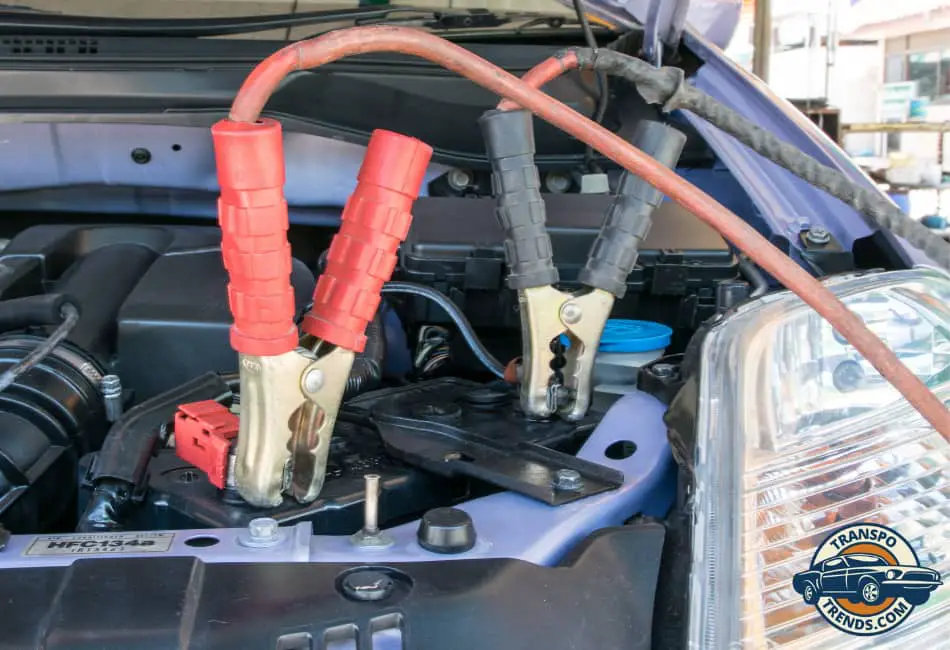We’ve all been there: you’re running late for work, you hop into your car, turn the key, and… nothing.
The dreaded dead battery strikes again. In a moment of desperation, you grab your trusty jumper cables and ask your neighbor for a jump-start.
Problem solved, right? But what if this scenario becomes a daily occurrence? It’s time to address the elephant in the room: is it bad to jump-start a car daily?
In this article, we’ll delve into the possible consequences of frequent jump-starting, exploring the impact on your car’s battery, electrical system, and overall health.
By understanding these effects, we can better appreciate the importance of proactive maintenance and problem-solving to avoid relying on daily jump-starts.
So, buckle up and join me as we navigate the ins and outs of jump-starting and learn how to keep our cars running smoothly without putting them at risk.
Understanding Jump-Starting a Car
Before we dive into the potential consequences of frequent jump-starting, let’s first establish a solid understanding of what jump-starting a car entails and its importance in emergency situations.
Explanation of What Jump-starting a Car Entails
Jump-starting a car involves using jumper cables to connect one vehicle’s dead battery to another vehicle’s charged battery.
This process allows the charged battery to temporarily provide enough power to start the car with the dead battery.
Once the engine is running, the car’s alternator takes over to recharge the dead battery and maintain the electrical system’s operation.
Importance of Jump-starting In Emergency Situations
Jump-starting is an essential skill for any driver, as it can be a lifesaver in emergency situations when your car’s battery dies unexpectedly.
It enables you to get your car running again quickly without the need for a tow truck or professional assistance.
This can be particularly useful in remote areas or during unfavorable weather conditions where waiting for help may not be a viable option.
Common Reasons Why a Car May Require Jump-starting
There are several reasons a car may require a jump-start, including:
- Leaving the headlights or interior lights on for an extended period while the engine is off, which can drain the battery.
- Cold weather, which can affect the battery’s performance and capacity.
- Old or weak batteries that may struggle to hold a charge.
- Alternator issues that prevent the battery from being recharged while driving.
- Electrical problems or parasitic drains slowly deplete the battery’s charge over time.
Now that we’ve covered the basics of jump-starting a car let’s move on to the potential consequences of doing this frequently.
Potential Consequences of Frequent Jump-Starting
While jump-starting can be a lifesaver in emergency situations, repeatedly jump-starting your car can have several negative consequences on its overall health.
Let’s explore the potential impacts of frequent jump-starting on your car’s battery, electrical system, and other components.
1. Impact on the Battery’s Health
The car battery is responsible for providing the initial power required to start the engine and run essential electrical systems when the engine is off.
However, batteries have a limited lifespan and can become less effective over time, particularly if they are subjected to frequent draining and recharging cycles.
Constantly jump-starting your car puts additional strain on the battery, forcing it to work harder to provide the necessary power for starting the engine.
This increased demand can accelerate the rate at which the battery degrades, potentially leading to a shorter overall lifespan.
As a result of the added strain from frequent jump-starting, your car’s battery may begin to exhibit reduced performance, such as slower cranking or difficulty holding a charge.
Eventually, this can lead to complete battery failure, necessitating a costly replacement.
2. Effects on the Electrical System
Modern vehicles rely on complex electrical systems to control various functions, including engine management, lighting, climate control, and entertainment systems.
These systems are designed to work within specific voltage ranges and can be sensitive to fluctuations or disruptions in power supply.
Repeatedly jump-starting a car can expose its electrical components to voltage spikes or irregularities that may cause damage or malfunction.
Additionally, improper jump-starting techniques, such as connecting the cables in the wrong order, can pose further risks to the vehicle’s electrical system.
Over time, the cumulative effects of frequent jump-starting can lead to various electrical issues, ranging from blown fuses and damaged wiring to more severe problems like fried control modules or sensor failures.
These malfunctions can be costly to diagnose and repair, especially if they involve critical systems like engine management or safety features.
3. Wear and Tear on the Vehicle
In addition to the battery and electrical system, frequent jump-starts can also put extra stress on other parts of your car, such as the starter motor and alternator.
These components work together to start the engine and maintain the electrical system’s operation, and their performance can be adversely affected by constant jump-starting.
The starter motor, in particular, may experience increased wear and tear due to the repeated forceful engagement required during jump-starts.
Similarly, the alternator may be subjected to additional stress as it works to recharge the battery after each jump-start.
Over time, this strain can contribute to premature failure or reduced efficiency of these components.
Ultimately, relying on daily jump-starts can have a cumulative negative effect on various aspects of your car’s health, leading to decreased performance, increased maintenance costs, and potential safety concerns.
By addressing the underlying causes of battery issues and adopting proper maintenance practices, you can avoid these consequences and ensure your car remains reliable and efficient.
Potential Effects on the Donor Vehicle During Jump-Starts
Here are a few possible impacts on the vehicle providing the jump-start:
Battery Strain:
When jump-starting another car, the donor vehicle’s battery shares its power to help start the recipient’s engine.
While a single instance may not cause significant strain, frequent jump-starting can gradually deplete the donor battery’s charge and place additional stress on it, potentially affecting its performance and lifespan.
Voltage Fluctuations:
During the jump-start process, the electrical systems of both vehicles are temporarily connected.
This can expose the donor car’s electrical components to voltage fluctuations or irregularities, which may lead to malfunctions or damage in sensitive systems over time.
Increased Wear on the Alternator:
The donor car’s alternator is responsible for recharging its battery after providing power to jump-start another vehicle.
Frequently offering jump-starts can place extra demand on the alternator, leading to increased wear and tear and potentially shortening its lifespan.
Risk of Improper Connections:
If the jumper cables are connected incorrectly during the jump-starting process, both vehicles can be exposed to potential electrical damage.
This risk reinforces the importance of following proper jump-starting procedures and ensuring that all connections are made correctly to protect both the donor and recipient cars.
While offering occasional assistance to a fellow motorist in need is generally safe, it’s essential to be aware of these potential impacts on the donor vehicle and exercise caution when providing jump-starts frequently.
The Main Impacts on Donor Car-Summary
If the donor car is used to jump-start another vehicle every day, the main impact would be increased strain and wear on its battery, alternator, and electrical system.
This frequent demand for extra power can lead to accelerated degradation of the battery’s performance and lifespan, as well as potential damage to the alternator and sensitive electrical components due to voltage fluctuations or irregularities.
Over time, this can result in decreased reliability, increased maintenance costs, and possibly the need for premature replacement of key components in the donor car.
Tips for Minimizing the Impact of Frequent Jump-Starting on Both Vehicles
To minimize the negative consequences of frequent jump-starting, it’s essential to follow proper maintenance practices and take precautionary measures for both the donor and recipient cars.
Here are some tips to help protect the health and longevity of both vehicles involved in the jump-start process:
1. Addressing the Root Causes of Battery Issues
Perform Regular Battery Maintenance
Regularly inspect your car’s battery for signs of corrosion, damage, or loose connections. Clean the terminals and ensure that cables are secure to maintain optimal performance.
Monitor Battery Health
Check your car battery’s charge level and overall health using a multimeter or a dedicated battery tester. Replace the battery if it’s no longer holding a sufficient charge or nearing the end of its expected lifespan.
Identify and Resolve Underlying Issues
Investigate potential reasons for frequent battery drainage, such as a faulty alternator, parasitic draw, or leaving accessories on when the engine is off. Address these issues promptly to prevent the need for constant jump-starts.
2. Proper Jump-starting Techniques
Follow Correct Procedures
Always adhere to the proper jump-starting sequence by connecting cables in the right order: positive to positive, then negative to a grounded point on the recipient vehicle’s chassis.
Use High-quality Jumper Cables
Invest in a set of good quality, heavy-duty jumper cables with adequate insulation and sturdy clamps to ensure a reliable connection and minimize the risk of electrical issues.
Ensure Both Vehicles are off Before Connecting
Before attaching the jumper cables, ensure both the donor and recipient cars are switched off to prevent voltage spikes and potential damage to electrical components.
3. Caring for the Donor Vehicle
Limit the Frequency of Providing Jump-starts
While occasional assistance to other motorists is generally safe, avoid using your vehicle as a donor for daily jump-starts to minimize the strain on its battery, alternator, and electrical system.
Monitor the Donor Car’s Battery and Alternator Health
Regularly inspect and test the donor vehicle’s battery and alternator to ensure they are in good condition. Address any signs of wear or damage promptly to prevent further issues.
Educate Yourself on Safe Jump-starting Practices
Familiarize yourself with proper jump-starting techniques and safety precautions to protect both your vehicle and the recipient’s car from potential damage during the process.
Conclusion
Frequent jump-starting can have significant consequences on both the recipient and donor vehicles, leading to increased strain on their batteries, electrical systems, and other components.
By addressing the root causes of battery issues, practicing proper jump-starting techniques, and considering alternative solutions such as portable jump starters and battery maintainers, you can minimize the negative impacts associated with frequent jump-starts.
In addition, prioritizing regular vehicle maintenance and preventative care is crucial for ensuring the reliability and longevity of your car, as well as reducing the need for constant jump-starts.
By taking a proactive approach to vehicle care and exploring alternative emergency solutions, you can protect the health of your car and any donor vehicles involved in the jump-starting process, ensuring a safe and dependable driving experience for all parties involved.

